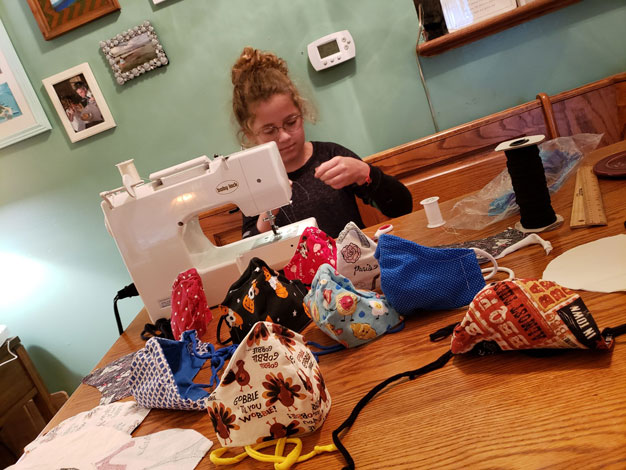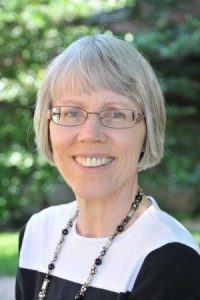
Julia Gilbert of St. Paul the Apostle Parish in Davenport makes masks for faculty, staff and students at St. Paul the Apostle Catholic School.
By Barb Arland-Fye
Editor
DAVENPORT — Teachers at St. Paul the Apostle Catholic School received an unusual gift from a student when they returned to school to prepare for the new academic year during the ongoing pandemic.
Sixth-grader Julia Gilbert presented the teachers with 30 fabric face masks that she and her mother, Rachel, made. They created another 180 masks for the school to distribute to Julia’s schoolmates as needed.
“She wrote us a sweet note with instructions on how to wear them,” said Octavia Houtekier-Boyd, the school’s assistant principal, referring to the masks for teachers. “She also delivered masks the next day, this time in student sizes so that if one of her schoolmates forgot a mask they could have a fun homemade one, instead of a disposable mask from the office. We just love how she was thinking of others (us) while she was away from school.”
“I wanted everyone at school to have a comfortable mask with a tie instead of elastic so it wouldn’t hurt their ears,” Julia said. “It’s important to wear a mask to protect others and to wear it over your mouth and your nose because your mouth and nose are connected,” added Julia, the daughter of parents who work as emergency room nurses.
Sewing face masks has provided Julia with an opportunity to help protect others, spend quality time with her mom and reduce worries about her parents, Rachel said.
Julia’s dad, John, works full-time in the emergency room of UnityPoint Health Trinity campuses in the Quad-Cities and is a sidelines cheerleader for the mask project. Her mom works part-time while attending grad school. Colleagues working in an emergency room become like family because of their experiences dealing with trauma, Rachel said. In the early weeks of the pandemic, hospitals put out calls for face masks. She and Julia wanted their friends in the emergency room to be protected. So they decided to learn how to make face masks.
First, they had to get a sewing machine and learn how to sew. They purchased a used one from a friend for $100. “Julia paid for half of it and I paid the other half,” Rachel said. They watched YouTube videos for tutorials.
Their project involved trial and error and adjustments based on people’s needs, face size and facial hair. They decided on the Olson Mask because it includes a nose piece and fits the face of the wearer. They found that ties made from T-shirt strips work better for comfort than elastic. The masks prevent eyeglasses from fogging and ears from being irritated.
Julia selected fabrics printed with things she likes such as fruits, sparkles, dogs and dinosaurs. Parishioners with boys provided guidance on selecting patterns boys might prefer, Rachel said. Another member of their parish, Tom Brooke, secured a donation through Thrivent Financial to purchase materials. Other friends donated T-shirts when the cost of purchasing new ones ate into funds for making masks.
“I got interested in making masks after I saw all the other masks that people were making,” Julia told The Catholic Messenger. She also wanted to learn how to sew. “It’s fun. Every once in a while I need a break,” she said.
“It was an activity for us to do together in the evening,” Rachel said. They often watched a video on demand subscription service while working in assembly line style — cutting and sewing pieces together. Rachel estimates they have created 500 masks to date. Production has slowed down considerably because people have easy access to masks now and mother and daughter have school work to do. Besides, Julia is ready to move on to new sewing projects: making scrunchies (hair bands), aprons, a skirt and pajama pants.
(Contact Editor Barb Arland-Fye at arland-fye@davenportdiocese.org)







